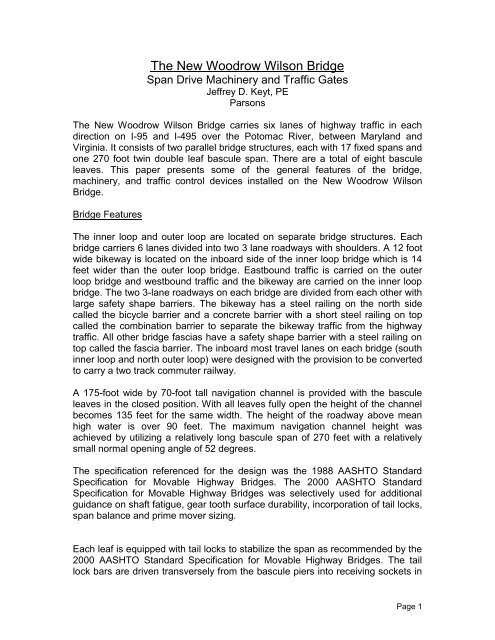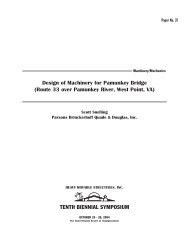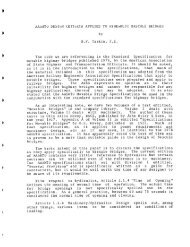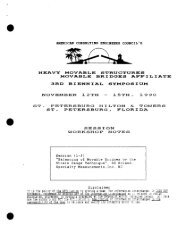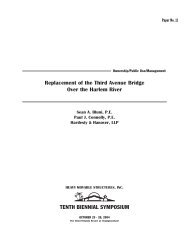The New Woodrow Wilson Bridge - Heavy Movable Structures, Inc.
The New Woodrow Wilson Bridge - Heavy Movable Structures, Inc.
The New Woodrow Wilson Bridge - Heavy Movable Structures, Inc.
You also want an ePaper? Increase the reach of your titles
YUMPU automatically turns print PDFs into web optimized ePapers that Google loves.
<strong>The</strong> <strong>New</strong> <strong>Woodrow</strong> <strong>Wilson</strong> <strong>Bridge</strong>Span Drive Machinery and Traffic GatesJeffrey D. Keyt, PEParsons<strong>The</strong> <strong>New</strong> <strong>Woodrow</strong> <strong>Wilson</strong> <strong>Bridge</strong> carries six lanes of highway traffic in eachdirection on I-95 and I-495 over the Potomac River, between Maryland andVirginia. It consists of two parallel bridge structures, each with 17 fixed spans andone 270 foot twin double leaf bascule span. <strong>The</strong>re are a total of eight basculeleaves. This paper presents some of the general features of the bridge,machinery, and traffic control devices installed on the <strong>New</strong> <strong>Woodrow</strong> <strong>Wilson</strong><strong>Bridge</strong>.<strong>Bridge</strong> Features<strong>The</strong> inner loop and outer loop are located on separate bridge structures. Eachbridge carriers 6 lanes divided into two 3 lane roadways with shoulders. A 12 footwide bikeway is located on the inboard side of the inner loop bridge which is 14feet wider than the outer loop bridge. Eastbound traffic is carried on the outerloop bridge and westbound traffic and the bikeway are carried on the inner loopbridge. <strong>The</strong> two 3-lane roadways on each bridge are divided from each other withlarge safety shape barriers. <strong>The</strong> bikeway has a steel railing on the north sidecalled the bicycle barrier and a concrete barrier with a short steel railing on topcalled the combination barrier to separate the bikeway traffic from the highwaytraffic. All other bridge fascias have a safety shape barrier with a steel railing ontop called the fascia barrier. <strong>The</strong> inboard most travel lanes on each bridge (southinner loop and north outer loop) were designed with the provision to be convertedto carry a two track commuter railway.A 175-foot wide by 70-foot tall navigation channel is provided with the basculeleaves in the closed position. With all leaves fully open the height of the channelbecomes 135 feet for the same width. <strong>The</strong> height of the roadway above meanhigh water is over 90 feet. <strong>The</strong> maximum navigation channel height wasachieved by utilizing a relatively long bascule span of 270 feet with a relativelysmall normal opening angle of 52 degrees.<strong>The</strong> specification referenced for the design was the 1988 AASHTO StandardSpecification for <strong>Movable</strong> Highway <strong>Bridge</strong>s. <strong>The</strong> 2000 AASHTO StandardSpecification for <strong>Movable</strong> Highway <strong>Bridge</strong>s was selectively used for additionalguidance on shaft fatigue, gear tooth surface durability, incorporation of tail locks,span balance and prime mover sizing.Each leaf is equipped with tail locks to stabilize the span as recommended by the2000 AASHTO Standard Specification for <strong>Movable</strong> Highway <strong>Bridge</strong>s. <strong>The</strong> taillock bars are driven transversely from the bascule piers into receiving sockets inPage 1
<strong>The</strong> <strong>New</strong> <strong>Woodrow</strong> <strong>Wilson</strong> <strong>Bridge</strong>Span Drive Machinery and Traffic GatesJeffrey D Keyt, PEParsonsthe tail ends of the bascule girders. <strong>The</strong> tail locks raise the counterweightstransferring counterweight dead load to the tail lock bar. This upward reaction atthe tail creates a moment that increases the dead load reaction on the live loadbearings located on the leaf side of the trunnion axis. This increased live loadbearing reaction reduces the possibility of uplift at the live load bearings during atransient live or rail load condition.A cast steel hub, a rotating forged steel shaft and bronze bearings were selectedfor the simply supported trunnion configuration. <strong>The</strong> trunnion design uses a caststeel hub to connect the trunnion shaft to the web of each girder. <strong>The</strong> trunnionjournals rotate in bronze sleeve bearings that rest on top of steel towers.Span Drive Machinery Description<strong>The</strong> eight leaves are driven by dedicated span drive machineries located on thebascule piers below the roadway deck and between the girders. Each leaf isequipped with a separate electromechanical machinery system. <strong>The</strong> componentsused on each leaf are identical to the other leaves with the exception of theheights of the rack weldments, the lengths of the intermediate shafts and theheights of the reducer supports. <strong>The</strong> design leaf speed is 0.13 RPM whichrequires a total reduction from the shaft of the electric motor to the leaf of 13512to 1. This is accomplished using a rack and pinion with a ratio of 12.714 to 1 andquadruple reduction enclosed gearing. <strong>The</strong>re are two double reductionsecondary reducers acting in parallel and one double reduction differentialprimary reducer. <strong>The</strong> primary and secondary reducers are in series. All reducersfeature through hardened gearing, splash lubrication, anti-friction bearings and aratio of 32.6 to 1.Each leaf is equipped with two motors rated for 150 HP at 1750 RPM. Bothmotors are connected to opposite ends of the continuous input shaft of theprimary reducer. Only one motor is energized at one time to power the leaf. <strong>The</strong>non-energized motor rotates under no load. <strong>The</strong> motor to be energized ismanually selectable by the operator. <strong>The</strong>re is no provision to operate the motorssimultaneously. <strong>The</strong> 150 hp motors are 480 volt, three phase, vector duty squirrelcage motors. Redundant Flux Vector drives provide automatic speed control ofthe motors.All machinery components were designed to resist their proportional share of150% of the Full Load Motor Torque (FLMT) produced by the 150 hp motor. <strong>The</strong>design HP for the primary reducer and each input shaft was 225 hp with themotor operating at its normal rated speed. <strong>The</strong> primary reducer output shafts,intermediate floating shafts, secondary reducers, pinions and racks are designedfor 112.5 hp at their respective normal rotational speeds.<strong>The</strong> normal angle of opening is 52 degrees. A maximum leaf speed of 0.13 RPMor 0.78 degrees per second will yield an opening time of 85 seconds with 10-Page 2
<strong>The</strong> <strong>New</strong> <strong>Woodrow</strong> <strong>Wilson</strong> <strong>Bridge</strong>Span Drive Machinery and Traffic GatesJeffrey D Keyt, PEParsonssecond acceleration periods. <strong>Inc</strong>reasing the operating time (decreasing thespeed) would require less horsepower and increase the required total speedreduction ratio, but would not reduce the size of the rack, pinion or speedreducers because the required leaf torque would be the same.An electric power supply and distribution system was provided to supply thebascule span with power from two different electric substations, both on theVirginia side. <strong>The</strong> cable run to the Virginia shore is much closer than theMaryland shore.Many bridges are equipped with either a smaller auxiliary drive motor and asuitable generator or an internal combustion engine drive either directly drivingthe machinery, or using a hydraulic pump and motor. <strong>The</strong> leaf operation isgenerally slower to minimize the size of the auxiliary drive components. Auxiliaryoperation on the <strong>Woodrow</strong> <strong>Wilson</strong> <strong>Bridge</strong> is provided by redundant motors andgenerators in the event both sources of electrical power are unavailable. <strong>The</strong>alternate drive motors provide a redundant motor of the same size. <strong>The</strong> fluxvector drives are also redundant. One generator is provided for the Marylandbascule pier and one generator is provided for the Virginia bascule pier. <strong>The</strong>starting of leaf motion on each pier can be staggered to minimize the maximumcurrent draw and yet minimize the increase in the total time to open all leaves.All four thrustor brakes on any one leaf are energized and de-energized togetherregardless of which motor is selected for operation. <strong>The</strong> thrustors are selfcontained electro-hydraulic actuators and are equipped with needle valves toprovide a time delay from the time electric power is removed to the time theshoes are fully set around the wheel. A time delay setting of approximately 2seconds was set for the machinery brakes and 0.6 seconds for the motor brakes.This delays the setting of the machinery brakes so all brakes do not begin toapply torque simultaneously. <strong>The</strong> location of the machinery brakes on thesecondary reducer input shaft is between the differential and the pinion providinga positive holding torque on the nearest pinion only. <strong>The</strong> braking torques is thehighest torques to be resisted by the machinery under normal circumstances andis approximately 180% FLMT when all brakes are operating simultaneously.<strong>The</strong> span drive closes the leaf and motor torque holds the leaf in the seatedposition until the brakes are set. <strong>The</strong> span drive motor is de-energized and thelocks are driven. Once the span locks and tail locks are driven the brakes releaseand allow the machinery to spin to the zero torque state. <strong>The</strong> brakes are then setand the machinery remains in the zero torque state until the next opening.Page 3
<strong>The</strong> <strong>New</strong> <strong>Woodrow</strong> <strong>Wilson</strong> <strong>Bridge</strong>Span Drive Machinery and Traffic GatesJeffrey D Keyt, PEParsonsfascia girder. <strong>The</strong> transverse slope as well a longitudinal slope are present on thebascule span.<strong>The</strong> transverse slope causes the southernmost bascule leaf structures to belocated at higher elevations than the northernmost ones. <strong>The</strong> trunnions on anyone leaf are at the same elevation but the North girder is always lower. Thisresults in the racks being different from each other. <strong>The</strong> elevation of the trunnionsfrom leaf to leaf rises from North to South. <strong>The</strong> spacing between the girdersvaries from leaf to leaf with the greatest distance between girders on thenorthernmost roadway. <strong>The</strong> southernmost roadway has the narrowest girderspacing and the girder spacing of the center two leaves are equal to each other.This variation of the girder spacing between leaves caused the intermediate shaftlength to vary, as well as the location of the trunnion bore in the bascule girderweb. <strong>The</strong>re are six different racks, each with their own shop drawing, and eightdifferent bascule girders. One rack is used in six different locations and the restin two locations each.Two Rack supports are welded to the bottom of the bottom flange of each girder.<strong>The</strong> rack support near the counterweight is a weldment consisting of a bottomflange welded to a web and stiffeners which are welded to the bottom flange ofthe bascule girder. <strong>The</strong> rack support near the live load bearing consists of a platewelded around its perimeter to the bottom flange of the bascule girder. <strong>The</strong>bottom surfaces of both rack supports were machined to provide two flat andparallel surfaces with a finish of 125 micro inches. <strong>The</strong>se details provide twodiscrete connections that can be adjusted with shims.<strong>The</strong> rack mounting surfaces on the girders were machined with portable millingmachines in the shop while the leaf was assembled. <strong>The</strong> milled surfaces wereparallel to each other and perpendicular to the milled areas of the bascule girderwebs.<strong>The</strong> pinion shaft locations are adjustable by varying the shim thickness under thepillow blocks or adjusting the locations of the pillow blocks. Any adjustments tothe pinion shaft location would affect the rack and pinion alignment at alllocations along the rack equally. <strong>The</strong> following alignment adjustments arepossible with the rack and pinion. All directions referenced assume the leaf is inthe closed position.Installing shims that are beveled transversely (in the direction of the trunnionaxis) would enable adjustments that could correct a condition where the rack andthe trunnion axes were not parallel in a vertical plane.Removing the bolts that secure the rack to the girder, pivoting the boltedconnections about one point and installing new fasteners in reamed holes wouldenable adjustments that could correct a condition where the rack and trunnionaxes were not parallel in a horizontal plane.Page 5
<strong>The</strong> <strong>New</strong> <strong>Woodrow</strong> <strong>Wilson</strong> <strong>Bridge</strong>Span Drive Machinery and Traffic GatesJeffrey D Keyt, PEParsonsGate Design RequirementsDuring the bridge design phase of this project it became apparent that the gaterequirements for this bridge would be very demanding. <strong>The</strong> demands includedheavy traffic, high travel speeds, a wide bikeway, infrequent openings usually atnight and bridge aesthetics. <strong>The</strong> longest gates would be required to span threetravel lanes, two shoulders, a bikeway, the combination barrier and the bicyclebarrier.Three types of gates were used. Warning gates provide a warning to motoristsand pedestrians with a visual barrier that warns of unsafe conditions ahead. <strong>The</strong>hazards to a vehicle passing the warning gates include colliding with the leaf,traveling off the end of a leaf or falling between the deck sections near thecounterweight. Warning gates or dedicated pedestrian gates also warnpedestrians of the unsafe conditions of an open or moving leaf. A pedestriancould travel off the open end of a walkway and fall or be exposed to injuriouscontact with the moving leaf. <strong>The</strong> projected amount of pedestrian traffic wasuncertain but separate pedestrian gates would reduce design and operatingconstraints on the warning gates. Resistance gates (Barrier gates) providephysical barrier across the roadway to prevent a vehicle from colliding with theleaf or falling between the decks. Some barrier gates are designed to be impactattenuating in order to reduce forces applied to the gate and structure and moreimportantly for the safety of the vehicle occupants.Based upon AASHTO, MUTCD, traffic safety principles and common sense, thefollowing traffic control and gate design goals were established:Warn the traffic miles in advance using variable message boards.Provide flashing red signal lights to command the traffic to stop on thebridge approach at least one span away from the bascule pier.Provide warning gates across all on-going and off-going roadways.Provide impact attenuating barrier across the on-going roadways to stopvehicles traveling in the normal travel direction that did not stop fro thewarning gates. <strong>The</strong> stopping force of the barrier gate should not cause anexcessively violent impact to the vehicle.Provide separately controlled pedestrian gates on the bikeway.Minimize the effect of the gates to the appearance of the bridge.Pedestrian Gates<strong>The</strong> pedestrian gates were located inboard of the bicycle barrier in a dedicatedspace that did not reduce the width of the bikeway. Two gates were installed oneach approach to the bascule to provided redundancy and the ability to stoppedestrians from moving towards the bascule span while allowing pedestriansalready on the span to continue moving and exit the span. <strong>The</strong> moving panelwas detailed to complement the pattern of the pedestrian railing.Page 7
<strong>The</strong> <strong>New</strong> <strong>Woodrow</strong> <strong>Wilson</strong> <strong>Bridge</strong>Span Drive Machinery and Traffic GatesJeffrey D Keyt, PEParsonsPedestrian Gate<strong>The</strong> pedestrian gate panel details complement the bicycle railing. <strong>The</strong> pivot axisis to the right.Warning GatesGate catalogs at the time did not depict standard products for arms long enoughfor this application but referred the purchaser to the gate company for a customdesigned gate. <strong>The</strong> warning gate should have High visibility while operating inorder to effectively warn the traffic to stop. <strong>The</strong> gate options available for warninggates included a semaphore type gate and a horizontal swing gate. <strong>The</strong>semaphore type had the most visibility while in motion before entering the travellane envelope. That was desirable due to the multiple high speed lanes.All roadways were to be protected by an on-going and off-going gate. <strong>The</strong> longarm length of at least 65 feet required a custom gate. If gates with a semaphoretype motion were used with the arm stored in the vertical position, the tip of thearm would be the highest point on the bridge. A horizontal swing gate could bestored above the railings for a much smaller visual impact than the semaphoregate stored in the vertical position. <strong>The</strong>re were concerns that a horizontal swinggate would have limited visibility to traffic until it has moved into the travel lane. Agate having the semaphore type motion that could be stored next to and orabove the railings would satisfy both the safety and aesthetic concerns. Asolution to the aesthetic and safety goals was discovered moving the axis ofrotation of the gate. If the gate arm shaft axis is aligned to be midway betweenthe stowed and deployed positions, 45 degrees from the direction of travel andstill in a level plane, the arm will rise and move from the stowed position to thedeployed position in one motion. From the stowed position, the gate arms moveupward, over and across the roadway and downward to span the roadway in thehorizontal position.Page 8
<strong>The</strong> <strong>New</strong> <strong>Woodrow</strong> <strong>Wilson</strong> <strong>Bridge</strong>Span Drive Machinery and Traffic GatesJeffrey D Keyt, PEParsonsWarning Gate Arm<strong>The</strong> warning gate in the stowed position behind the fascia barrier. <strong>The</strong>reflectorized striping faces inboard only. Sign structures are visible in thebackground.<strong>The</strong> warning gates were located outboard the parapet barriers and outboard ofthe bikeway railing. <strong>The</strong>re are eight warning gates installed on the bridge. Twodifferent sizes of warning gates were designed. <strong>The</strong>re were two gates with a 86foot arm installed on the north side of the inner loop spanning the roadway andthe bikeway. <strong>The</strong> remaining six gates are some 10 feet shorter and only crossthe roadways.Warning Gate Housing and Counterweight<strong>The</strong> warning gate counterweight in the stowed position behind the bicycle barrier.<strong>The</strong> counterweight is to the left and the machinery housing and gong are to theright. <strong>The</strong> narrow slots in the bicycle barrier are visible.Gates usually require gaps in railings or occupy space on sidewalks. <strong>The</strong> gateswere detailed to minimize the discontinuities in bridge parapet railing, bicyclebarrier railing pedestrian railing. A steel box connected the gate arm with the gatetrunnion and counterweight. <strong>The</strong> box had an opening in the bottom surface toPage 9
<strong>The</strong> <strong>New</strong> <strong>Woodrow</strong> <strong>Wilson</strong> <strong>Bridge</strong>Span Drive Machinery and Traffic GatesJeffrey D Keyt, PEParsonsallow a short section of railing to fit inside the box when the gate was in thedeployed position. Only two 4 inch wide slots were required in the bicycle barrierand the pedestrian railing for the warning gate in the deployed position.Warning Gate<strong>The</strong> warning gate in the stowed position behind the bicycle barrier. <strong>The</strong> narrowslots in the combination barrier railing are visibleBarrier Gates<strong>The</strong> roadways are divided with large safety shape barriers so discrete roadwaysand travel directions could be gated. It was decided to equip the bridge withbarrier gates on all approach (ongoing) roadways and no barrier gates on the offgoing roadway. This provides maximum protection to motorists traveling in thestandard travel direction from improper vehicle operation and malfunctioning orinoperative components. <strong>The</strong>se components include bascule leaves, warninggates and traffic signals.<strong>The</strong> barrier gates protect motorists failing to heed the warning of the trafficsignals and the warning gates and traveling in the standard traffic flow directionfrom colliding with and open leaf or from leaving the end of the roadway. Someincidents and accidents have occurred when components are inoperative suchas signals, gates, and even bascule leaves. A double leaf bascule span with oneleaf inoperative becomes a single leaf with one approach open to the channel,similar to a swing bridge or vertical lift bridge.A vertical lift type barrier gate was capable of placing an impact attenuatingenergy dissipating gate across the roadway. Gates fabricated by Lokran werestudied and selected for this project based on the safe stopping performance andthe history of prior installations. A vehicle is brought to a stop by the gate througha wire rope unwinding off of a reel. <strong>The</strong> rotation of the reel is resisted by a brake.If the energy of the vehicle being stopped is less than the design energy for thePage 10
<strong>The</strong> <strong>New</strong> <strong>Woodrow</strong> <strong>Wilson</strong> <strong>Bridge</strong>Span Drive Machinery and Traffic GatesJeffrey D Keyt, PEParsonso 4 Pedestrian GatesAcknowledgementsSponsoring agenciesMaryland State Highway AdministrationVirginia DOTDC DOTFHWAGeneral Engineering ConsultantPotomac Crossing ConsultantsContractorAmerican <strong>Bridge</strong>/KramerStructural Steel FabricatorPDMMachinery FabricatorSteward Machine CompanyWarning and Pedestrian GatesB&B RoadwayBarrier GatesLockranElectrical and ControlsWellington PowerPanatrolPage 13


